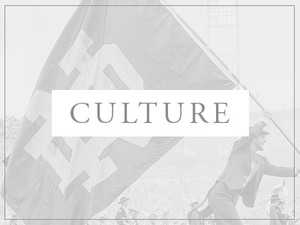 "
"
The views of this author are not necessarily the views of Scholastic Magazine.
The year is 1986, and Steffanie Keller is nervous. It’s her freshman year at Notre Dame, and she has just been assigned her first story as a writer for Scholastic. Some of her nerves stem from her anxiety about proving herself as a writer, but mostly she’s afraid that she won’t be able to do such a controversial story justice. Many people on- and off-campus consider the topic taboo and uncomfortable, and they will make their opinions known after it is published.
Her piece is about the Notre Dame administration’s refusal to officially recognize a group called Gays and Lesbians at Notre Dame and Saint Mary’s College (GLND/SMC). Keller eventually titles her article, “A Struggle for Recognition.”
In 1986, society at large was not accepting of members of the LGBTQ+ community. Casual homophobia was commonplace, and sodomy laws were upheld by the Supreme Court. Thus, queer people sought to create their own safe spaces and communities to support each other and live as their authentic selves. The GLND/SMC was one such community.
However, the university administration believed that officially recognizing such a group would serve as “an implicit sanction for a homosexual lifestyle,” according to David Tyson, C.S.C, then-vice president of student affairs. Thus, the group was not able to advertise in university-owned media, hold meetings in campus facilities or have an address in the campus phone directory.
In response to a letter from the GLND/SMC, Tyson deemed the University Counseling Center and University Ministry the most “appropriate” way to meet LGBTQ+ students’ needs. Many gay students took offense at the suggestion that they go to the UCC or University Ministry.“It implies that we are sick and sinful,” then co-chairman of the GLND/SMC, student Joseph Acosta, said in the 1986 Scholastic article.
University policies prevented the creation of a safe place on campus for LGBTQ+ students to go to for support without violating a rule or being treated as though something was wrong with them. Martin Fitzpatrick, a gay Notre Dame alumnus who graduated Class of ’90 said, “While I don't recall any overt or direct homophobic incidents during my time at ND, merely having such policies in place makes a statement in itself, and lets you know you're not fully welcome or accepted.”
This refusal to recognize GLND/SMC did not stop queer students from being open and expressing themselves, however. The policies of the university “certainly created an underground,” Fitzpatrick said, but it did still exist. And while Notre Dame did not have any organizations for gay students, that did not necessarily prevent them from valuing their time at Notre Dame. Fitzpatrick said, “I had better exposure to life’s experiences at Notre Dame than I was having at home, and it was still eye opening.”
The year is 2021, and I am nervous. I’m about to move in to my “Home Under the Dome” for the next four years, Johnson Family Hall, and leading up to Welcome Weekend my fears about being a bisexual student at a Catholic institution moved to the forefront of my mind. Walking through the doors, I’m afraid that I’ll have to hide an important part of who I am in order to avoid being judged.
Those fears are assuaged almost immediately by the sight of rainbow pride and ally pins displayed unapologetically on the sign-in table. Papers that designate rooms as “safe spaces” are all around the dorm. There’s a flyer for an LGBTQ+ Welcome Back Picnic on an announcement board. It’s almost as if the University is going out of its way to tell me that not only am I seen, but I am loved. I wonder what changed from the Notre Dame of 1986, that my mother (Steffanie Keller, now Steffanie Early) wrote about her own freshman year.
The answer, as I’ve learned, is quite a lot.
In 2012, after five months of review, Notre Dame approved a Pastoral Plan “to expand and enhance the support of and services for students who identify as gay, lesbian, bisexual, transgender and questioning (GLBTQ), including the creation of a University recognized student organization.” PrismND became the first University recognized LGBTQ+ student organization shortly thereafter in 2013.
Another part of this plan included adding programming and support for LGBTQ+ students through pre-existing campus organizations, such as the Gender Relations Center (GRC), which was founded in 2004. Arlene Montevecchio, the Director of the GRC, said that the “GRC’s mission is to promote the moral formation of students around issues of gender, relationships and sexuality.”
The GRC, in conjunction with PrismND and Student Government, held a “Welcome Back Picnic” for LGBTQ+ students and allies in August 2021. Holding such events reflects “[The GRC’s] hope that our programming helps people feel more welcome on campus, and that people who are not part of the LGBTQ community who come across our programs would be allies, and learn to practice active allyship,” as Montevecchio said.
In the initial letter to the administration asking for university recognition, the GLND/SMC wrote, “Concerning gays, lesbians and intolerance, we are working toward a day when homosexuality is considered an ordinary, noncontroversial aspect of everyday life.” It is my belief, and the belief of the people I spoke to, that such a day has not yet been universally realized. Homophobia still exists in society and not every student on campus is an active ally for LGBTQ+ students.
But Notre Dame (and much of the world) has grown, and will continue to grow. Being a force for good in the world means promoting the welfare of marginalized communities and making sure that, going forward, we don’t only recognize LGBTQ+ students, but welcome them.